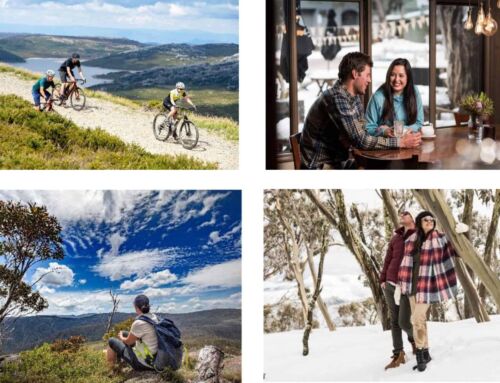Words by: Michelle Lindsay
“Stay safe next week … you know the concerns we have for you.”
They’re not the words you want to hear when setting off on a hiking adventure in the remote centre of Australia. Especially when they’re coming from an expert on the trail, TRC Director Janet Mackay, who was instrumental in taking the trail from a series of unknown tracks in the desert to one of Australia’s most iconic and beloved hiking trails.

At 230 km long, the Northern Territory’s Larapinta Trail stretches from Alice Springs in the east to Mt Sonder in the west, winding across the ridges, valleys and gorges of the West MacDonnell range. It’s renowned for its exceptional views, tough terrain and extreme weather – hot in the day and freezing at night.
Together with two friends, I recently completed a 6-day ‘self-guided’ trip to the trail, which took in around half of the trail, 110 km, from Ellery Creek to the summit of Mt Sonder. The company we booked with provided our food, equipment transfers, logistics and maps, which made the planning easy. We’d arranged a food drop at our mid-point at Ormiston Gorge, where we’d also added clean socks and undies, a fresh shirt and a nice bottle of red. They also provided an itinerary of how far we’d need to walk each day – including two days of almost 30 km of walking each.

It was these long days that worried me – and Janet – who rightly informed me that the section had been intended to be done over two days, and covered some of the roughest terrain we’d see over our 6-day journey. After raising our concerns with the company, they brightly informed us that everyone ‘made it’ – and that the long days were to avoid having to carry extra water, which is short supply between the maintained tanks at the major camping areas.
We set off on a sunny Tuesday morning, carrying packs that weighed around 18–20 kg– with our water, food, essentials, tents and sleeping bags. The first day, around 15km, was a great intro to the trail and fairly uneventful, until we got to the camp and discovered that the zip to Fran’s tent was broken. This would not have been an issue, except for the high numbers of mice around the campsite with a reputation for sneaking into tents in search of food, and her fear of a rodent visitor in the night. Resourceful as we were, we used the duct tape in our repair kit to seal her in, and called for a replacement when we were able to get reception at a high point the next day (one of just two spots with reception on our section of the trail).

Day 2 brought incredible scenery from Counts Point lookout, across an awe-inspiring half-pipe valley that extended miles ahead (and which we were to walk the next day). On this leg, we encountered plenty of day trippers/no-pack walkers, and felt simultaneously jealous and mildly superior! That afternoon, we arrived in camp to a new tent for Fran, plus a pile of ‘sorry’ snacks from the tour company, which we shared with the hungry looking end-to-end walkers who were already 10+ days into their hike (superiority complex lost).
Day 3 was the first of our big days (30km), and we set off at 4 am to maximise the time we had to make our destination before dark. We made our way quietly through the cool and magical Inarlanga Pass under torchlight, with the large boulders slowing our progress considerably, and raising our concerns for the day. As the sun rose, we congratulated ourselves for making the 10 before 10 (10 km before 10 am, and a mantra among the through hikers).

However, the next stretch – past the beautiful Waterfall Gorge – took us up the steep and rocky side of an escarpment, with tricky foot placements and some exposure making it hard and intimidating walking. By our lunch break we were behind schedule and already tired, although the view from the top and some tuna on rice cakes helped cheer us up.

The afternoon was long and hot, and we trudged into the setting sun with flagging energy and mood. As night fell, we still had a few kilometres to go – and they felt like the longest of the trip. This last leg wasn’t helped by the fact that two of three headtorches failed, and we had to make our way with our trusty tent lanterns like some travellers of old.
We eventually made it into camp by 8.30pm, totally exhausted, but we still had to find a campsite (most were taken) and pick up our food drop – as well as find the only shower available for the whole trip. We drank the wine in the food box directly from the bottle on the steps of the shower, then fell into our tents without dinner.
Despite the ordeal, this section of the walk was probably the most rewarding and scenic. We also only met one other (hardcore, trail-running) hiker who elected to do this leg in one sprint. Given the chance again, we would have split this section in two and had more time to soak in the incredible country.

The next day was a scheduled ‘rest’ day, with just 10 km to walk to the glorious and refreshing Finke River campsite. While we managed a dip and would have loved to have laid down our packs for the day, we couldn’t face doing the 27 km scheduled for the following day, so we elected to press on and reduce the kilometres ahead. That was possibly the best decision of the trip, as with some excellent beta from fellow walkers, we located a small campsite high on the hill. With no facilities or water, it was just us and the spectacular sunset vista in all directions. We had ticked off seven kilometres from the next day and were feeling strong and capable. And away from other campers we had the quiet and space to reflect on the incredible majesty of the Larapinta and how privileged we were to be there, and with each other. And the stars!

The remainder of the trip went without major incident, and we were treated to the variety of the array of wildflowers and varying terrain and micro-systems that make the Larapinta so special. The finale of Mount Sonder at sunrise was a fitting end to what was an amazing journey. While we were tired and sore, the Larapinta had shown us what it was famous for, and given us an experience to remember forever.
I’d like to acknowledge the Arrente people, the Traditional Owners and Custodians of the land the Larapinta Trail crosses, and thank them for the opportunity to explore their hard, ancient and beautiful Country.






